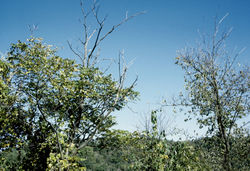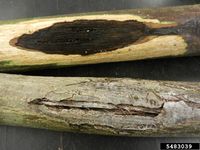Ophiognomonia clavigignenti-juglandacearum
| Literature database |
|---|
| 26 articles sorted by: |
| • year (recent ones first) |
| • research topics |
| • countries/regions |
| • host plants |

Author(s): Joseph O'Brien, USDA Forest Service
Source: Wikimedia Commons
Ophiognomonia clavigignenti-juglandacearum (N.B. Nair, Kostichka & J.E. Kuntze) Broders & Boland 2011 - (butternut canker)
The fungus causes a serious and lethal canker disease on Juglans cinerea trees in North America. Up to 70-90% declining trees have been observed in some areas. The disease was first reported in 1967 from Wisconsin, but quickly spread to neighbouring states. The origin is unclear, but could be in Asia because Asian walnut species are resistant.
The fungus produces asexual spores which enter the tree through cracks in the bark. Cankers develop on the main trunk, branches and roots. They form pycnidia and release again spores. These spread through rainsplashes. In addition, several insect species have been found to carry spores and might contribute to the disease spread.
| Vernacular names | |
|---|---|
| • Deutsch: | Sirococcus-Krebs der Walnuss |
| • English: | butternut canker |
| • Français: | chancre du noyer cendré |
For details see the review by Broders et al. 2015 and the respective page in Wikipedia.
Synonyms:
Sirococcus clavigignenti-juglandacearum
- Other images of Ophiognomonia clavigignenti-juglandacearum (IPM Images - click to enlarge)

